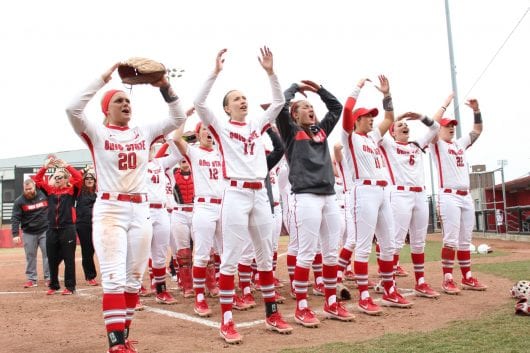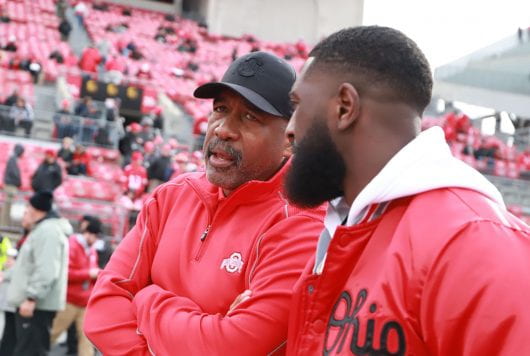
Ohio State gives a shout out to the crowd after defeating Indiana 2-0 on March 24, 2019. Credit: Gretchen Rudolph | For The Lantern
Ohio State athletic director Gene Smith and the athletic department wasted little time granting senior spring sport student-athletes an extra year of eligibility, but not all Big Ten programs did the same.
The March 30 NCAA vote left the decision up to each university, but unlike schools such as Ohio State, Michigan and Penn State, Wisconsin will not grant extra eligibility, and Iowa has yet to come to a final decision.
It’s a choice that impacts hundreds of athletes, hundreds of thousands of dollars per university, and the difference in policy from school to school will shift the competitive balance of spring sports in the Big Ten.
“There was an overreaction by the NCAA when they canceled spring sports, giving everyone that year of eligibility,” Alvarez said during his radio show this past Wednesday. “That creates a lot of problems. It’s more complicated than that as far as numbers, and then you have another group coming in.”
Ohio State spring sport coaches were in contact with Smith before and after the NCAA vote, and Smith said they cut their program budgets “significantly” to aid his ultimate decision.
Smith said Ohio State will extend financial aid to returning seniors, and he estimated the university’s total cost of returning seniors to be nearly $900,000. Smith said the decision would be more challenging for schools with less resources, but fairness was not part of the NCAA Division I Council’s discussion.
“We probably gain a competitive balance advantage because our kids can come back and others can’t,” he said.

Gene Smith and Parris Campbell talk before the game against Penn State Nov. 23. Ohio State won 28-17. Credit: Cori Wade | Assistant Photo Editor
The Hawkeyes are still working through the issue, Iowa athletic director Gary Barta said on a Zoom conference this past Thursday. It will cost the university approximately $500,000 to allow seniors to return.
Although financial challenges will affect the Iowa athletic department, student athletic scholarships will not be affected, Barta said.
“We will be reducing everything that we do except the scholarship bill, and that’s usually between $13-14 million,” Barta said. “That commitment we’re not planning to take away is scholarship money from any student-athletes.”
Assistance for less fortunate athletic departments isn’t coming from the NCAA either.
After losing significant revenues from the cancellation of NCAA tournaments, the NCAA announced a $375 million cut from the amount of money given annually to DI schools after a vote from the NCAA Board of Governors March 26.
“Losing that money that you were anticipating from the tournament was substantial to our budget,” Alvarez said.
Roster size also poses an issue for schools with returning seniors. With a new freshman class coming up and seniors returning, the roster will be inflated with two freshman classes since all players will receive an extra year of eligibility.
“You’ve got a group of freshmen coming in. Do you want this group coming back? How does that handle roster size?” Alvarez said.
Ohio State’s spring sports’ rosters will grow with the 31 seniors who decided to return, Smith said. However, there were 39 seniors who decided to forgo another season.
With senior student-athletes having opportunities lined up after their collegiate career, Ohio State and Wisconsin alike stressed the importance of moving forward.
“We tried to encourage our seniors to go ahead and graduate and move on with their life,” Alvarez said. “We appreciate everything that you’ve done, but move forward.”
While the NCAA granted a waiver of blanket eligibility, it does not require schools to match seniors’ previous financial aid, which could place a financial burden on athletes who chose to return.
Michigan welcomed back its seniors but stressed the importance of student-athletes making the best decision for their individual situations.
“Every school comes at this from a different perspective and their own unique situation,” Michigan associate athletic director for external communications Kurt Svoboda said during a radio show on Michigan Insider Monday. “It’s not just the unique, individual schools that are making individual decisions. It’s each individual athlete that has a unique set of circumstances.”
Penn State also plans to invite senior student-athletes to return under the NCAA waiver.
“We’re very pleased and support the NCAA decision to extend eligibility,” Penn State athletic director Sandy Barbour said during a press conference on Zoom April 2.
Alvarez said other students affected by COVID-19 did not get another chance, citing study abroad students or those impacted by senior concert cancellations, so neither should student-athletes.
“One group shouldn’t be cherry-picked to get credit and get to come back to pick that year of eligibility,” Alvarez said.
Smith said that if the eligibility vote impacted fall sports, the deliberation among athletic departments would be different.
“I think if it was football we’d have a different conversation, to be quite frank,” he said.


